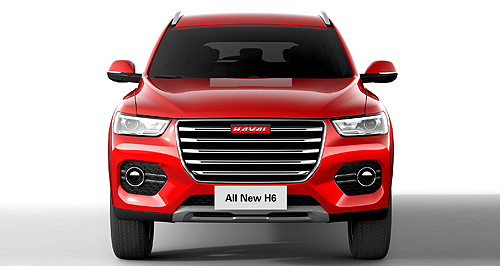Make / Model Search
News - HavalHaval lays bare three-year planIn the Wey: Chinese luxury SUV-maker Wey could make its debut in Australia and other international markets if all goes according to plan. Hybrid, electric powertrains to make up 30 per cent of Haval Australia sales by 202229 Jan 2018 By TUNG NGUYEN HAVAL Motors Australia has detailed its three-year product plan, bringing increased safety and technology to existing models in the coming years that will culminate in new-generation SUVs with electrified powertrains in 2020. Speaking to local journalists at the launch of the updated H9 last week, Haval Motors Australia public relations and product specialist Andrew Ellis said by 2022, almost one in three of the brand’s sales will be in a low-emissions powertrain. “Our target here in Australia is 30 per cent electric vehicles by 2022 – one in three Havals that we sell here in 2022 will be electric,” he said. “We would like a mix of PHEV (plug-in hybrid) and EV because some customers would still want that 600-700km range.” Mr Ellis said that the push for emissions-free motoring in the brand’s home-market of China will have a knock-on effect Down Under. “The big news for us globally, is what’s happening in China,” he said. “As from next year, every manufacturer that produces more than 300,000 vehicles will have to adopt a new energy vehicle score. In 2019, 10 per cent total production must be zero-emission or low-emission or they get some serious fines. “In 2020, it rises to 12 per cent and it just rises and rises every year. “So for Haval tomorrow, over the next couple of years, they are going to be investing $5 billion in hybrids and EVs.” Mr Ellis revealed the first all-electric vehicle will be uncovered in April during the Beijing motor show wearing an Ora badge – the new low-emissions sub-brand from parent company Great Wall Motors that will sit alongside luxury marque Wey and SUV specialists Haval. Reports indicate the soon-to-be-revealed model will be a mid-size SUV dubbed iQ5 that will be powered by a single electric motor producing around 120kW of power. Last November, Wey unveiled Great Wall Motors’ first plug-in hybrid production vehicle with the 250kW/520Nm P8 SUV at the Guangzhou motor show. While that vehicle is currently locked out for Australia due to its left-hand-drive production status, Mr Ellis did confirm the local arm has its hands firmly in the air to take the P8 if a right-hand-drive version were to become available. Either way, Haval Motors Australia will receive hybrid and EV powertrains in 2020 with the launch of the new-generation versions of its current SUV range – all built on a new modular platform with alternative engines in mind. “From 2020, that’s when we start getting excited,” Mr Ellis said. “The all-new platform – new H2, H6, H7, H9 will be following that. “A mix of hybrid and EV powertrains, all the latest safety technologies and, by this stage, this will be when the company is close to launching in the US – sometime in the next five years they are telling us for the US.” Before that though, Haval will launch an update to the recently-facelifted H9 large SUV seven-seater in the third quarter of this year that will include active safety technologies such as autonomous emergency braking, forward collision warning and adaptive cruise control. Smartphone mirroring technology, compatible with both Apple and Android, will also debut on the H2 small crossover in the latter half of 2018 before spreading to the remaining SUV line-up. Mr Ellis said the fresh product in 2018 is expected to push Haval’s local sales – which increased 148.3 per cent to 710 last year – into record numbers over the next 12 month period. “We’d like to do 1500 this year, it’s going to be double what we did last year,” he said. “It’s bold, but we’ve got to think big. “We still see H6 and H2 as the volume seller, but with H9 previously, I mean, the run rate on this is very small at the moment, we think we can double that pretty easily. “We do 25 of these a month and that’s 300 Haval H9s, so there’s 20 per cent of your target.” Looking ahead to the next year, Haval will bring an updated H6 mid-size SUV around the middle of 2019 with a revised exterior and interior, as well as an expected seven-speed dual-clutch automatic transmission to replace the existing six-speed unit. A new H2 will also lob around the same time with similar changes, but the local division will put its hand up for the more-stylish ‘S’ version to replace the current model. However, the Mazda CX-9-rivalling H7 seven-seater previously reported to be coming to Australian showrooms in early 2018 will now not arrive until a new-generation version arises in 2020, according to Mr Ellis. “Unfortunately, we’re not getting that one (H7), it’s been pushed back,” he said. “Because of the change with production, that H7 they are currently building will not be built in 12 months. “So for us, we looked at it and said ‘there’s not much point bringing a car where we launch it then wait 18 months for the all-new one’, so we will wait for the all-new one and make do with H2, H6, H9 and H8 – that will be our line-up for the next couple of years.”  Read more |
Click to shareHaval articlesMotor industry news |












Facebook Twitter Instagram